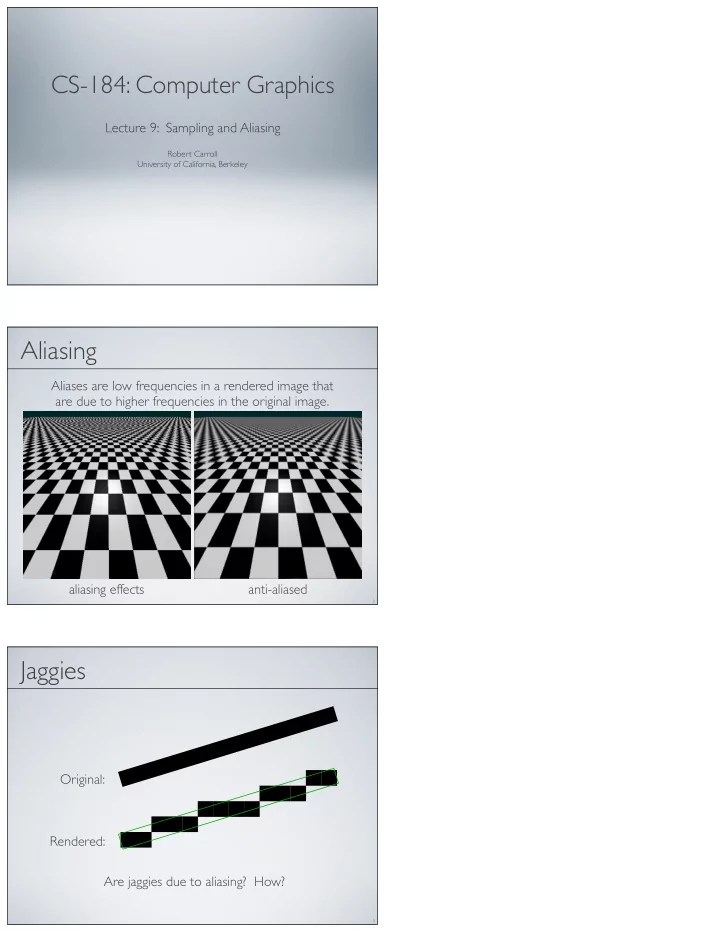

CS-184: Computer Graphics Lecture 9: Sampling and Aliasing Robert Carroll University of California, Berkeley Aliasing Aliases are low frequencies in a rendered image that are due to higher frequencies in the original image. aliasing effects anti-aliased 2 Jaggies Original: Rendered: Are jaggies due to aliasing? How? 3
Aliasing (temporal) http://www.michaelbach.de/ot/mot_wagonWheel/main.swf 4 Sampling How to represent a continuous signal digitally? image from Wikipedia 5 Undersampling Both frequencies could explain the samples 6
Aliasing Aliases are low frequencies in a rendered image that are due to higher frequencies in the original image. 7 What is a (point) sample? An evaluation ! At an infinitesimal point (2-D) ! Or along a ray (3-D) ! At a particular time (animation/audio) What is evaluated ! Inclusion (2-D) or intersection (3-D) ! Attributes such as distance and color ! Air pressure (audio) 8 Questions for this lecture How can we model/analyze the sampling process? How can we reconstruct a signal from samples? When can we do a good job (i.e. avoid aliasing)? 9
Reference sources Kurt Akeley’s slides Brian Curless’ slides Marc Levoy’s notes Ronald N. Bracewell, The Fourier Transform and its Applications, Second Edition, McGraw-Hill, Inc., 1978. 10 Ground rules You don’t have to be an engineer to get this ! We’re looking to develop instinct / understanding ! Not to be able to do the mathematics We’ll make minimal use of equations ! No integral equations ! No complex numbers Plots will be consistent ! Tick marks at unit distances ! Signal on left, Fourier transform on the right 11 Dimensions 1-D ! Audio signal (time) ! Generic examples (x) 2-D ! Image (x and y) 3-D ! Animation (x, y, and time) Most examples in this presentation are 1-D 12
Sampling and Reconstruction Remove high frequencies before sampling Continuous Signal Discrete Samples Don’t introduce spurious high frequencies during reconstruction Displays are discrete, so why do we need to reconstruct anyway? • Re sampling: Scaling up/down, texture mapping, supersampling 13 Filtering Filtering is used for both sampling and reconstruction Sampling: filter high frequencies from continuous signal • Diffusing filter for cameras or analog audio filter • Average multiple samples at a higher frequency ( Oversampling ) Reconstruction: filter samples to interpolate continuous signal • Reconstruction filters can introduce higher frequencies 14 Convolution One of the most common methods for filtering Function f and filter g ( f * g )( x ) = shift g by x and take product Commutative, associative, distributive Extends to higher dimensions and discrete functions 15
Convolution example * = 16 Convolution example (2D) * = 17 Sampling and Reconstruction Sampling (pre-filtered signal) Reconstruction (w/ box filter) x * comb(x) = = 18
Fourier analysis The Fourier transform lets us analyze functions in frequency domain • Natural in conjunction with convolution 19 Fourier series Any periodic function can be exactly represented by a (typically infinite) sum of harmonic sine and cosine functions. Harmonics are integer multiples of the fundamental frequency 20 Fourier series example: sawtooth wave 1 … … -1 1 21
Sawtooth wave summation 1 2 3 n Harmonics Harmonic sums 22 Sawtooth wave summation (continued) 5 10 50 n Harmonics Harmonic sums 23 Fourier integral Any function (that matters in graphics) can be exactly represented by an integration of sine and cosine functions. Continuous, not harmonic 24
Basic Fourier transform pairs f(x) F(s) 25 Basic Fourier transform pairs comb(x) comb(s) f(x) F(s) 26 Reciprocal property Swapped left/right from previous slide f(x) F(s) 27
Basic Fourier transform pairs (2D) f(x) F(s) 28 Basic Fourier transform pairs (2D) f(x) F(s) 29 Scaling theorem f(x) F(s) 30
Band-limited transform pairs f(x) F(s) 31 Finite / infinite extent If one member of the transform pair is finite, the other is infinite ! Band-limited ! infinite spatial extent ! Finite spatial extent ! infinite spectral extent 32 Convolution theorem Let f and g be the transforms of f and g . Then: Something difficult to do in one domain (e.g., convolution) may be easy to do in the other (e.g., multiplication) 33
Sampling theory x * Spectrum is replicated an infinite number of = = times f(x) F(s) 34 Reconstruction theory x * = = f(x) F(s) 35 Sampling at the Nyquist rate x * = = f(x) F(s) 36
Reconstruction at the Nyquist rate x * = = f(x) F(s) 37 Sampling below the Nyquist rate x * = = f(x) F(s) 38 Reconstruction below the Nyquist rate x * = = f(x) F(s) 39
Reconstruction error Original Signal Undersampled Reconstruction 40 Reconstruction with a triangle function x * = = f(x) F(s) 41 Reconstruction error Original Signal Triangle Reconstruction 42
Reconstruction with a rectangle function x * = = f(x) F(s) 43 Reconstruction error Original Signal Rectangle Reconstruction 44 Sampling a rectangle x * = = f(x) F(s) 45
Reconstructing a rectangle (jaggies) x * = = f(x) F(s) 46 Sampling and reconstruction Aliasing is caused by ! Sampling below the Nyquist rate, ! Improper reconstruction, or ! Both We can distinguish between ! Aliasing of fundamentals (demo) ! Aliasing of harmonics (jaggies) 47 End 48
Recommend
More recommend